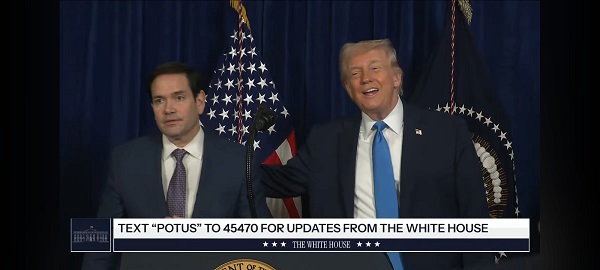Energy
‘Anti-human’: Tucker Carlson, Michael Shellenberger blast John Kerry’s COP28 speech

From LifeSiteNews
‘I think it’s fair to call it a death cult at this point, when you’re stifling energy supplies that are necessary to keep people alive, allow poor people to escape the use of wood and dung, I don’t know what else you call it than an anti-human death cult,’ Shellenberger told Carlson.
American conservative firebrand Tucker Carlson and journalist Michael Shellenberger recently blasted Democratic climate czar John Kerry for giving an “anti-human” speech at this year’s United Nations COP28 “climate change” conference.
Making the strong statements during the Monday edition of his X (formerly Twitter) show, Carlson played a clip of Kerry, who serves as U.S. special presidential envoy for climate, explaining at the COP28 conference in Expo City, Dubai on Sunday that he sees the global elimination of coal-fired power plants as an essential measure in tackling so-called “climate change.”
Ep. 44 Another half-demented 80-year-old yelling about things he doesn’t understand. These are our leaders. They don’t care about our future because they don’t have one of their own. pic.twitter.com/iylpXALJjZ
— Tucker Carlson (@TuckerCarlson) December 4, 2023
Calling Kerry and many in U.S. President Joe Biden’s administration “half-demented 80-year-olds,” Carlson pointed out that despite the pleas of Kerry and others like him, other nations are moving full-stream ahead with the burning of coal as a means of powering their countries, and thereby sustaining their populations and economies.
“China, for example, burns more coal each year than the rest of the world combined… this year, the Chinese have generated 14 percent more electricity from coal than they did last year; same thing in India,” Carlson said, adding that other large nations such as Indonesia have also ramped up their use of coal.
Carlson argued that this presents a hypocrisy among the Biden administration, which often talks about “climate change” and the purported role of the West in the creation of the so-called crisis while ignoring the behavior of China, India and other nations.
Continuing his show, Carlson interviewed journalist Michael Shellenberger about the behavior of Kerry and other members of the political establishment, inquiring what he sees as the true motivation behind the climate “religion.”
Shellenberger replied by accusing the global “elite” of having an outright hatred for humanity, pointing to the fact that politicians, including the British prime minister, took private jets to the recent U.N. conference in Dubai, all the while increasing energy costs for ordinary citizens and harping on the need for their citizens to reduce energy consumption.
“I think that what’s so different now is that the elites are just openly and blatantly expressing their hatred of humankind, particularly the hatred of working people, of poor people,” Shellenberger told Carlson “the obvious alternative to coal is natural gas… if this was actually about ‘climate change’ you would just produce more natural gas because it produces half the carbon emissions of coal.”
“But John Kerry and other climate activists are against natural gas,” Shellenberger continued. “And they have been stifling the production of natural gas… it’s so obviously hypocritical but even worse than that I think it’s really anti-human… it really is about being against humankind, about being against humanity.”
Pointing to the fact that cheap and reliable energy is one of the main factors that keeps the masses out of poverty, particularly in places like India and China, Shellenberger characterized the West’s plans as akin to a “death cult,” in which Western leaders use “apocalyptic” language about the climate in an attempt to stop or limit the production of cheap energy, regardless of its human consequences.
“I think it’s fair to call it a death cult at this point, when you’re stifling energy supplies that are necessary to keep people alive, allow poor people to escape the use of wood and dung, I don’t know what else you call it than an anti-human death cult.”
Carlson replied in agreement, telling Shellenberger that far from being motivated by the health of the environment, the true goal is “tyranny.”
Kerry, under former President Barack Obama, was on the team that negotiated the Paris Accords, which demanded that successful, wealthy countries drastically cut back emissions. It was never voted on in the U.S. Senate as an official treaty. President Donald Trump pulled the country out of the accords, but the U.S. has rejoined the agreement under the Biden administration.
“A global transition away from oil, gas, and coal would not only harm U.S. economic development but also afflict harm on the poorest nations,” according to Alex Epstein, an energy policy commentator. “Fossil fuels are so uniquely good at providing low-cost, reliable energy for developing nations that even nations with little/no fossil fuel resources have used fossil fuels to develop and prosper. E.g. South Korea (83% FF), Japan (85% FF), Singapore (99% FF),” Epstein wrote recently on X.
The net-zero movement led by COP is particularly dangerous to Africa and other poor regions.
Consider: ⅓ of the world uses wood/animal dung for heating/cooking. 3B use less electricity than a typical American refrigerator.
Only FFs can provide the energy they need to develop. pic.twitter.com/u2f3uZpvPc
— Alex Epstein (@AlexEpstein) November 29, 2023
“Every prosperous country has developed using fossil fuels,” he wrote. “No poor country has been able to develop to the point of prosperity without massive FF use. The reason is that development requires energy, and FFs are a uniquely cost-effective, including scalable, source of energy.”
LifeSiteNews co-founder Steve Jalsevac, who has researched this topic for decades, says “implementing Kerry’s policies would result in hundreds of millions more deaths than they would save. That is the real intention,” he says, “world depopulation on a massive scale.”
Business
Virtue-signalling devotion to reconciliation will not end well

From the Fraser Institute
By Bruce Pardy
In September, the British Columbia Supreme Court threw private property into turmoil. Aboriginal title in Richmond, a suburb of Vancouver, is “prior and senior” to fee simple interests, the court said. That means it trumps the property you have in your house, farm or factory. If the decision holds up on appeal, it would mean private property is not secure anywhere a claim for Aboriginal title is made out.
If you thought things couldn’t get worse, you thought wrong. On Dec. 5, the B.C. Court of Appeal delivered a different kind of upheaval. Gitxaala and Ehattesaht First Nations claimed that B.C.’s mining regime was unlawful because it allowed miners to register claims on Crown land without consulting with them. In a 2-to-1 split decision, the court agreed. The mining permitting regime is inconsistent with the United Nations Declaration on the Rights of Indigenous People (UNDRIP). And B.C. legislation, the court said, has made UNDRIP the law of B.C.
UNDRIP is a declaration of the United Nations General Assembly. It consists of pages and pages of Indigenous rights and entitlements. If UNDRIP is the law in B.C., then Indigenous peoples are entitled to everything—and to have other people pay for it. If you suspect that is an exaggeration, take a spin through UNDRIP for yourself.
Indigenous peoples, it says, “have the right to the lands, territories and resources which they have traditionally owned, occupied or otherwise used or acquired… to own, use, develop and control, as well as the right to “redress” for these lands, through either “restitution” or “just, fair and equitable compensation.” It says that states “shall consult and cooperate in good faith” in order to “obtain free and informed consent prior to the approval of any project affecting their lands or territories and other resources,” and that they have the right to “autonomy or self-government in matters relating to their internal and local affairs, as well as ways and means for financing their autonomous functions.”
The General Assembly adopted UNDRIP in 2007. At the time, Canada sensibly voted “no,” along with New Zealand, the United States and Australia. Eleven countries abstained. But in 2016, the newly elected Trudeau government reversed Canada’s objection.
UN General Assembly resolutions are not binding in international law. Nor are they enforceable in Canadian courts. But in 2019, NDP Premier John Horgan and his Attorney General David Eby, now the Premier, introduced Bill 41, the Declaration on the Rights of Indigenous Peoples Act (DRIPA). DRIPA proposed to require the B.C. government to “take all measures necessary to ensure the laws of British Columbia are consistent with the Declaration.” The B.C. Legislature unanimously passed the bill. (The Canadian Parliament passed a similar bill in 2021.)
Two years later, the legislature passed an amendment to the B.C. Interpretation Act. Eby, still B.C.’s Attorney General, sponsored the bill. The amendment read, “Every Act and regulation must be construed as being consistent with the Declaration.”
Eby has expressed dismay about the Court of Appeal decision. It “invites further and endless litigation,” he said. “It looked at the clear statements of intent in the legislature and the law, and yet reached dramatically different conclusions about what legislators did when we voted unanimously across party lines” to pass DRIPA. He has promised to amend the legislation.
These are crocodile tears. The majority judgment from the Court of Appeal is not a rogue decision from activist judges making things up and ignoring the law. Not this time, anyway. The court said that B.C. law must be construed as being consistent with UNDRIP—which is what Eby’s 2021 amendment to the Interpretation Act says.
In fact, Eby’s government has been doing everything in its power to champion Aboriginal interests. DRIPA is its mandate. It’s been making covert agreements with specific Aboriginal groups over specific territories. These agreements promise Aboriginal title and/or grant Aboriginal management rights over land use. In April 2024, an agreement with the Haida Council recognized Haida title and jurisdiction over Haida Gwaii, an archipelago off the B.C. coast formerly known as the Queen Charlotte Islands. Eby has said that the agreement is a template for what’s possible “in other places in British Columbia, and also in Canada.” He is putting title and control of B.C. into Aboriginal hands.
But it’s not just David Eby. The Richmond decision from the B.C. Supreme Court had nothing to do with B.C. legislation. It was a predictable result of years of Supreme Court of Canada (SCC) jurisprudence under Section 35 of the Constitution. That section guarantees “existing” Aboriginal and treaty rights as of 1982. But the SCC has since championed, evolved and enlarged those rights. Legislatures can fix their own statutes, but they cannot amend Section 35 or override judicial interpretation, even using the “notwithstanding clause.”
Meanwhile, on yet another track, Aboriginal rights are expanding under the Charter of Rights and Freedoms. On the same day as the B.C. Court of Appeal decision on UNDRIP, the Federal Court released two judgments. The federal government has an actionable duty to Aboriginal groups to provide housing and drinking water, the court declared. Taxpayer funded, of course.
One week later, at the other end of the country, the New Brunswick Court of Appeal weighed in. In a claim made by Wolastoqey First Nation for the western half of the province, the court said that Aboriginal title should not displace fee simple title of private owners. Yet it confirmed that a successful claim would require compensation in lieu of land. Private property owners or taxpayers, take your pick.
Like the proverb says, make yourself into a doormat and someone will walk all over you. Obsequious devotion to reconciliation has become a pathology of Canadian character. It won’t end well.
Energy
The U.S. Just Removed a Dictator and Canada is Collateral Damage

Early this morning, the United States says it carried out a ground raid supported by air strikes inside Venezuela, reportedly involving elite U.S. forces, including Delta Force, and removed Venezuelan President Nicolás Maduro and his wife Cilia Flores from the country.
President Donald Trump confirmed the operation publicly and stated that the United States intends to “run Venezuela” during a transition period, explicitly including control over the country’s oil sector. That single statement should alarm Canada far more than any diplomatic condemnation ever could.
Kelsi Sheren is a reader-supported publication.
To receive new posts and support my work, consider becoming a free or paid subscriber.
While this move may be justified on moral or strategic grounds for the U.S., it is unequivocally bad news for Canada, really really bad. Canada’s energy position just weakened significantly and now Canada’s leverage with the United States has always rested on one simple fact: the U.S. needed Canadian oil.
Not liked it. Needed it.
Canada became Washington’s largest and most reliable foreign energy supplier not because it was cheap, fast, or efficient but because alternatives were unstable, sanctioned, or politically toxic. Venezuela was one of those alternatives.
It isn’t anymore.
If the U.S. succeeds in stabilizing Venezuelan oil production under its influence, Canada loses something it cannot easily replace and wish it did sooner, strategic indispensability. When your biggest customer gains options, your negotiating power not only shrinks, it completely disappears.
Venezuelan crude is largely heavy oil, the same category as much of Canada’s oil sands production. Many U.S. refineries, especially along the Gulf Coast, are designed to process heavy crude. For years, sanctions and mismanagement kept Venezuelan barrels off the market. Canadian heavy helped fill that gap. That advantage just cracked open. If Venezuelan supply re-enters global markets under U.S. oversight, Canadian oil faces more competition, downward pressure on prices, wider discounts for heavy crude and reduced urgency for new Canadian infrastructure. Urgency that Mark Carney refused to see was needed.
Canada’s oil is already expensive to extract and transport. It is already burdened by regulatory delays, pipeline bottlenecks, and political hostility at home. Now it faces a rival with larger reserves, lower production costs, shorter shipping routes and U.S. strategic backing
That is not a fair fight, but the liberals put us in this position and only have themselves to blame. Ottawa officially has no cards left to play. Canada’s response options are beyond limited and that’s the real problem.
Ottawa cannot meaningfully condemn the U.S. without risking trade and defence relations. It cannot influence Venezuelan reconstruction. It cannot outcompete Venezuelan oil on cost and it has spent years undermining its own energy sector in the name of climate virtue signalling. This is just the snake eating it’s tail and now realizing its proper fucked.
Canada is watching a major shift in global energy power from the sidelines, with no leverage and no contingency plan. This is the cost of mistaking morality for strategy. This is the cost of an ego gone unchecked.
Canada likes to tell itself that being stable, ethical, and predictable guarantees relevance. It doesn’t, Canada isn’t even in the game anymore it just hasn’t realized it. It only works when your partner has no better options.
The U.S. did not remove a communist dictator in Venezuela to protect Canadian interests. It did it to secure American interests energy, influence, and control. Thats what a real leader does, puts it’s country and it’s citizens first.
Canada’s reliability is now a nice bonus, not a necessity. That shift will show up quietly in trade negotiations, in infrastructure decisions and how quickly Canadian concerns get brushed aside. No dramatic break. Just less attention. Less urgency. Less patience and soon enough Canada won’t be invited to the table to even begin the conversation. Canada has just been down graded to the kids table.
This moment didn’t begin today. It began when Canada failed to build pipelines, ego drove away energy investment, allowed its regulatory system to become a chokehold and treated its largest export sector as an embarrassment.
While Ottawa debated optics, the U.S. planned for contingencies. Today was one of them.
The removal of a communist dictator in Venezuela may be a massive victory for it’s citizen and a strategic win for the United States but for Canada, it is a warning shot. Canada just became more optional in a world that punishes irrelevance quickly and quietly.
Being polite won’t save us. Being virtuous won’t save us.
Only being necessary ever did and today, Canada no longer became necessary.
KELSI SHEREN
– – – – – – – – – – – –
One Time Donation! – Paypal – https://paypal.me/
Buy me a coffee! – https://buymeacoffee.com/
Let’s connect!
Youtube – https://www.youtube.com/@
Instagram: https://www.instagram.com/
Substack: https://substack.com/@
TikTok – https://x.com/KelsiBurns
-

 International2 days ago
International2 days ago“Captured and flown out”: Trump announces dramatic capture of Maduro
-

 International2 days ago
International2 days agoTrump Says U.S. Strike Captured Nicolás Maduro and Wife Cilia Flores; Bondi Says Couple Possessed Machine Guns
-

 Energy1 day ago
Energy1 day agoThe U.S. Just Removed a Dictator and Canada is Collateral Damage
-

 International1 day ago
International1 day agoUS Justice Department Accusing Maduro’s Inner Circle of a Narco-State Conspiracy
-

 Haultain Research1 day ago
Haultain Research1 day agoTrying to Defend Maduro’s Legitimacy
-

 Business2 days ago
Business2 days agoVacant Somali Daycares In Viral Videos Are Also Linked To $300 Million ‘Feeding Our Future’ Fraud
-

 Daily Caller21 hours ago
Daily Caller21 hours agoTrump Says US Going To Run Venezuela After Nabbing Maduro
-

 International1 day ago
International1 day agoU.S. Claims Western Hemispheric Domination, Denies Russia Security Interests On Its Own Border




